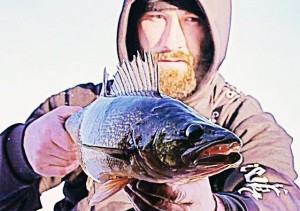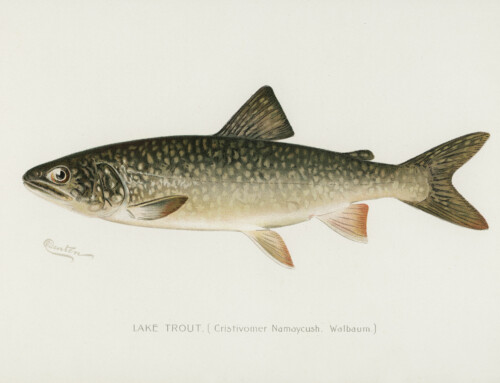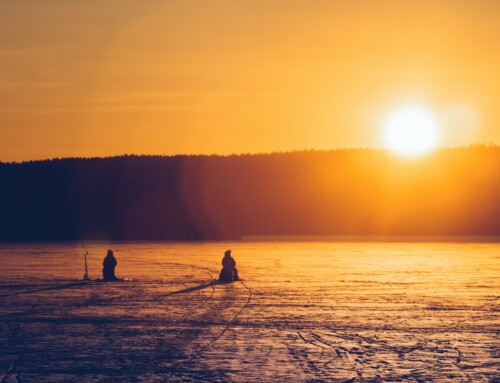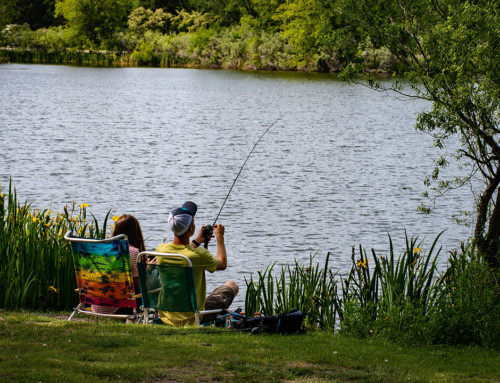Originally Published by Exist to Fish, November 23, 2015
By Alex Meletis
First ice has to be the most exciting time of the year for chasing walleye. On my home body of water, the legendary Bay of Quinte, large schools of migratory walleye stack up into the bay from Lake Ontario staging for the spring spawn. The same applies to all bodies of water.
Safety
When you venture out to fish early ice, your first priority should be safety. Ice reports for your local area can be found on weather networks, talking to local tackle shops, social and local media hubs and on fishing forums. Ice conditions can vary from day to day due to current or warming weather trends, so be aware of the conditions in the area and type of water system you are going to be fishing. Don’t take someone’s word for it, always be prepared with a spud to check for ice safety along with with proper ice safety gear such as a floater suit, ice picks and a charged cell phone in case you need to make an emergency call to local authorities. A GPS app is also important as you can send actual coordinates and other locational information.
Dress for the weather. Layers, proper foot wear, ice safety gear, and ice fishing gear such as a propane heater and an ice shelter are all things you will need to be comfortable and successful on the ice. Because I walk to the majority of the spots I fish, I use a FrabillCommando thermal one man flip over ice shelter paired with a long rope looped around my waist. Make sure you give yourself 15-20ft of rope extended behind you because If you were to go through the ice you do not want that ice hut to get pulled down with you or slide and hit you. Also, when walking I use my Frabill Ice spud checking the ice as I venture ahead.
Tactics
Early ice can produce multiple big fish days. I generally return to areas I had marked waypoints on where I caught fish late into the fall. The great thing is that walleye haven’t been harassed in many weeks at this time of year and are apt to chase baits.
There are reasons why fish congregate in particular areas such as bait fish, current and structure, along with time of day. I’ll focus on dusk periods as sunrise and sunset are key times in the early ice season because walleye tend to be sensitive to light and are low light feeders. During early dawn and dusk walleye tend to follow bait fish into the shallows (12-20 ft) while during the day they will tend to go deeper (20-30ft of water). For this reason I like to choose spots that are adjacent to deep water as walleye will tend to relate to the deepest basins during winter.
Targeting walleye in these areas, especially when ice is not at its thickest and lightly snow covered is important because they are extremely spooky when the sun is high. They can also get spooked by your auger and spud so sneak up and get into position before the prime time bite turns on maximizing your chances by minimizing noise. Early ice means a huge change in the environment as oxygen levels, barometric pressure, temperatures, light penetration and noise all become major factors during the early ice season. The less noise you make the better, especially during dusk periods of the day.
If you haven’t fished an area or body of water during the open water season, the use of Navionics (GPS) is invaluable to see the structure of a system.
Targeting structures like rocky points, reefs and sharp contours are great starting points as they could hold baitfish and thus, walleye. I like to determine a jigging pattern that calls fish in and stick with it. Every system may be different, but on the Bay of Quinte, a more aggressive jigging pattern seams to draw more fish in. This could be determined by the constant migration and movement of fish or due to the murky/stained water. In other areas like the Ottawa River or northern lakes, a more subtle jigging approach may work best, in addition to dead-sticking a minnow. My advice, stick to an area where you have marked or caught fish that morning or later in the day because chances are more fish will congregate in this area at days end. I have a rule, I don’t move once I have settled in after 4pm.
Once I have made it to one of my go to spots I put my trust into my stealthy 10″ Ion ice auger. I use all medium heavy 30″ Pro Tackle Ice Series rods with reels spooled with 20lb Power Pro paired with a 15lb fluorocarbon leader, when targeting these Quinte giants.
Like every different genre of fishing, lure selection can be overwhelming. For me, I’ll try to narrow down my presentation to simply mimicking the forage types that these walleye may be keying on such as various minnows and perch. My lure selection is varied on Quinte, in which I have four go to choices.
First off, I like a flashy bait such as a spoon, my new favorite being the Lake Fork Trophy Lures Flutter Spoon. If the flash doesn’t get it done I’ll go with a noise maker like the Rapala Ripin Rap.
Beyond these great choices I’ll go with a search bait like a Rapala Jigging or Snap Rap. Last but not least the simplest, but sometimes most effective, I’ll go with the good ol’ jig and minnow. One variation with the jig and minnow rig I like is the use of a plastic minnow imitator, in which case I like a Lake Fork Trophy Lures Magic Shad (fluke style body). All these baits attract fish differently but are extremely effective in the right conditions. One thing that has become a part of the equation for is adding scent to my artificial baits. For this my only choice is Liquid Mayhem Garlic Minnow which is made with real baitfish and lasts all day once applied.
Presentation
When I am fishing any of the baits I’ve just mentioned, I will experiment with the aggressiveness at which I jig, and the height that I lift the spoon and the cadence of jigging and pauses. As I said, an aggressive approach to jigging seems to be the best way to call up Walleye on Quinte, while snapping a spoon along with a couple second pause is perfect, but then what? Once I’ve spotted a Walleye on my flasher (Hummingbird Ice 45) it becomes a game of keep away, or cat and mouse. I never drop the bait down to or below a walleye, I entice them into chasing my offering forcing them into a quick hasty decision then bam! Fish on.
 First ice can be the most exciting fishing of the season. All systems are different as mentioned above but with the proper gear and doing your research, that fish of a life time is possible. Get out and explore this winter and have a safe first ice experience everyone.
First ice can be the most exciting fishing of the season. All systems are different as mentioned above but with the proper gear and doing your research, that fish of a life time is possible. Get out and explore this winter and have a safe first ice experience everyone.









